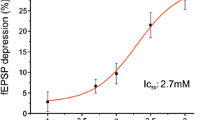Conclusions
-
1.
In various experiments both a decline and a rise in the effectiveness of ACh action was demonstrated after tetanization independently of the appearance of a PP or PTD. The “relative” effectiveness of ACh action in most cases declined during the PP and rose during the PTD.
-
2.
The observed changes in the effectiveness of ACh action were nonspecific, since they arose in response to a stimulation not only of the medial septum (cholinergic input) but also the dentate fascia (noncholinergic input). Testing of the responses arising during stimulation of the control (nontetanizing) input for the most part demonstrated a depression in the responses and a decline in the effectiveness of ACh action.
-
3.
No support was found in the present experiments for the hypothesis that the PP and PTD are based on corresponding changes in the sensitivity of the subsynaptic membrane to transmitter. The most probable PP mechanism is an increase in synaptic effectiveness due to an increase in transmitter release. The PTD mechanisms, possibly, involve changes at the level of the postsynaptic membrane and require further analysis.
Similar content being viewed by others
Literature cited
A. G. Bragin and O. S. Vinogradova, “Phenomenon of chronic potentiation in cortical afferent input of pyramids of hippocampal CA3 field,” in: Physiological Mechanisms of Memory [in Russian], Pushchino-on-Oka (1973), p. 8.
O. S. Vinogradova, “The Hippocampus and Memory [in Russian], Nauka, Moscow (1975).
L. L. Voronin, “Cellular mechanisms of conditioned-reflex activity,” Zh. Vyssh. Nervn. Deyat.,26, No. 4, 705 (1976).
L. L. Voronin, R. G. Kozhedub, and S. N. Kozhechkin, “Change in the sensitivity of septohippocampal responses to acetylcholine during prolonged posttetanic potentiation,” Byull. Éksp. Biol. Med.,139, No. 5, 515 (1980).
L. L. Voronin and I. E. Kudryashov, “Responses of hippocampal neurons during prolonged posttetanic potentiation,” Zh. Vyssh. Nervn. Deyat.,29, No. 1, 141 (1979).
L. L. Voronin, I. E. Kudryashov, and S. V. Ioffe, “Prolonged posttetanic potentiation in hippocampus and its relation with the mechanisms of the conditioned reflex,” Dokl. Akad. Nauk SSSR,217, No. 6, 453 (1974).
R. G. Kozhedub, S. N. Kozhechkin, and L. L. Voronin, “Influence of acetylcholine ionophoresis on cellular and focal septohippocampal responses,” Zh. Vyssh. Nervn. Deyat.,28, No. 2, 411 (1978).
I. N. Sharonova, L. L. Voronin, and V. G. Skrebitskii, “Prolonged posttetanic potentiation of hippocampal evoked responses to stimulation of Shaffer's collaterals,” Zh. Vyssh. Nervn. Deyat.,26, No. 1, 214 (1976).
B. E. Alger and T. J. Teylor, “Long-term and short-term plasticity in the CA1, CA3 and dentate regions of the rat hippocampal slice,” Brain Res.,110, 463 (1976).
P. Andersen, S. H. Sundberg, O. Sveen, and H. Wigström, “Specific long-lasting potentiation of synaptic transmission in hippocampal slices,” Nature,266, 736 (1977).
T. V. P. Bliss and T. Lomo, “Long-lasting potentiation of synaptic transmission in the dentate area of the anaesthetized rabbit following stimulation of the perforant path,” J. Physiol. (Engl.),232, 331 (1973).
J. L. Grawford and J. D. Connor, “Localization and release of glutamic acid in relation to the hippocampal mossy fibre pathway,” Nature,244, 442 (1973).
L. L. Iversen and J. Storm-Mathisen, “Uptake of3H glutamic acid in excitatory nerve endings in the hippocampal formation of the rat,” Acta Physiol. Scand.,96, 22A (1976).
G. S. Lynch, T. Dunwiddie, and V. Gribkoff, “Heterosynaptic depression: a postsynaptic correlate to long-term potentiation,” Nature,266, 737 (1977).
G. S. Lynch, V. K. Gribkoff, and S. A. Deadwyler, “Long-term potentiation is accompanied by a reduction in dendritic responsiveness to glutamic acid,” Nature,263, 151 (1976).
L. L. Voronin, “Cellular mechanisms of long-term posttetanic potentiation in the hippocampus,” in: Adv. Physiol. Sci., Vol.36, Cellular Analogues of Conditioning and Neural Plasticity, O. Fehér and F. Joo, eds., Pergamon Press, Akademiai Kiado, Budapest (1981), p. 165.
Author information
Authors and Affiliations
Additional information
Translated from Zhurnal Vysshei Nervnoi Deyatel'nosti imeni I. P. Pavlova, Vol. 32, No. 5, pp. 947–953, September–October, 1982.
Rights and permissions
About this article
Cite this article
Kozhedub, R.G., Voronin, L.L. & Kozhechkin, S.N. Action of acetylcholine on hippocampal responses during prolonged potentiation and depression following tetanization of the medial septum and dentate fascia. Neurosci Behav Physiol 14, 153–158 (1984). https://doi.org/10.1007/BF01185223
Received:
Issue Date:
DOI: https://doi.org/10.1007/BF01185223




